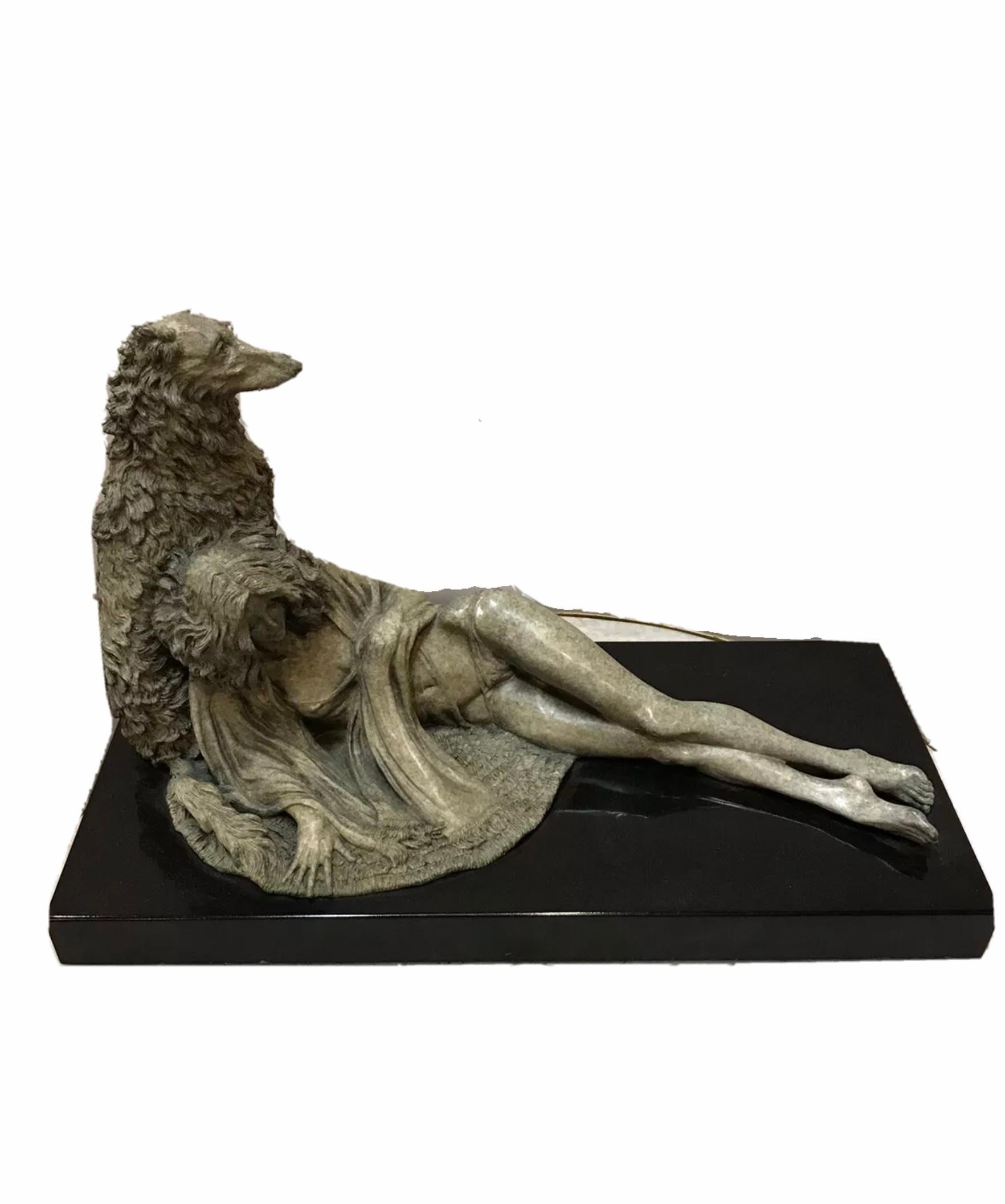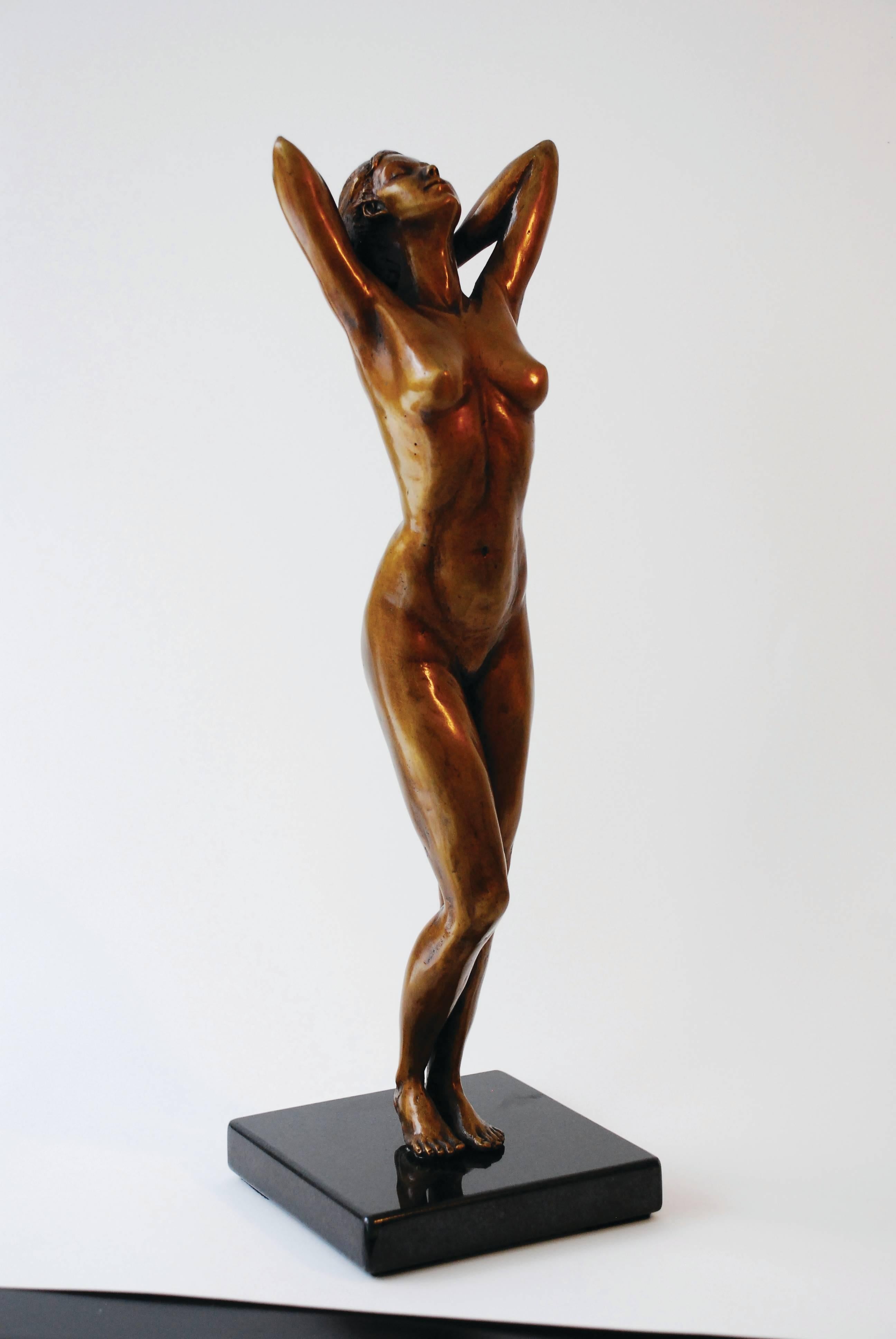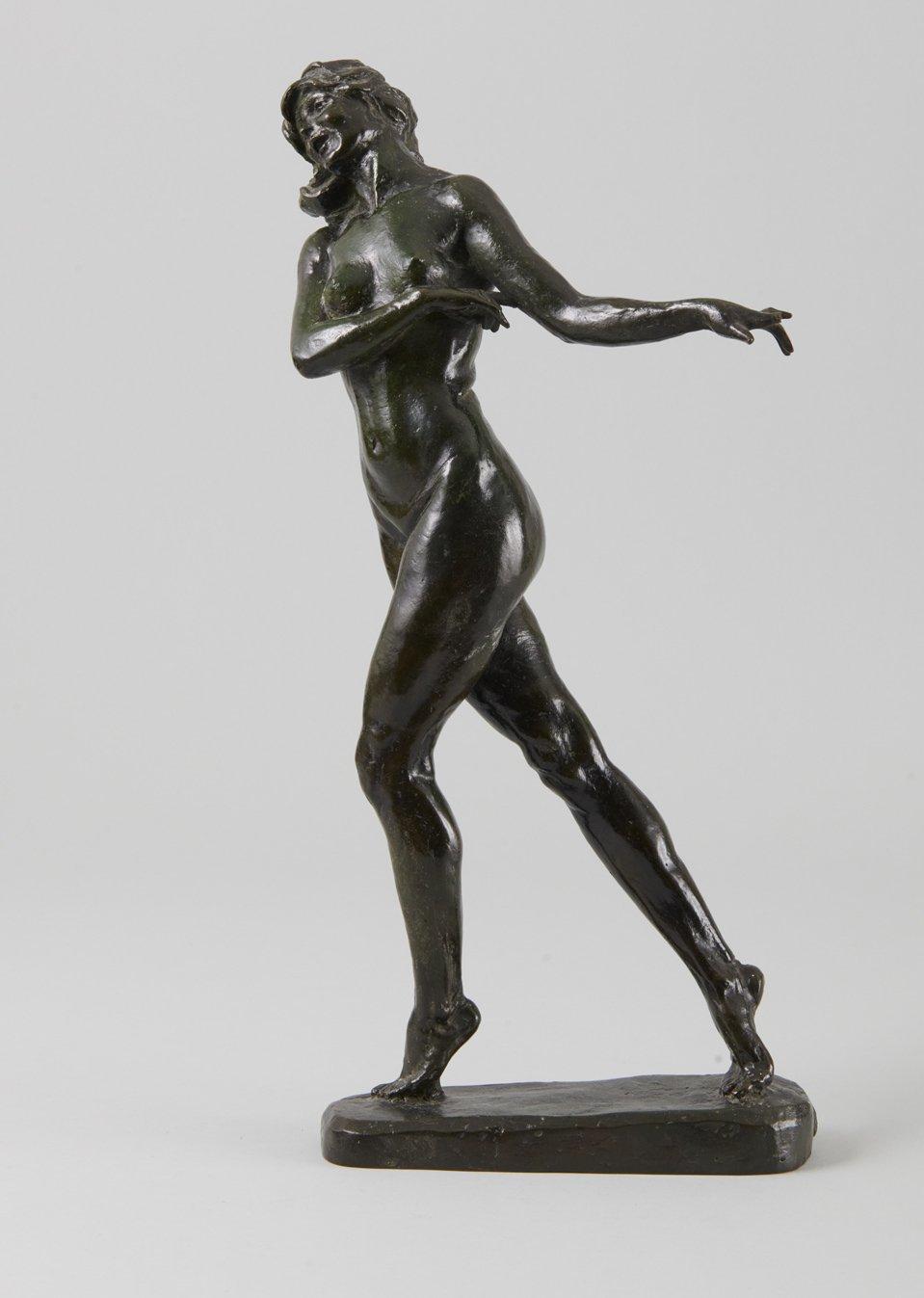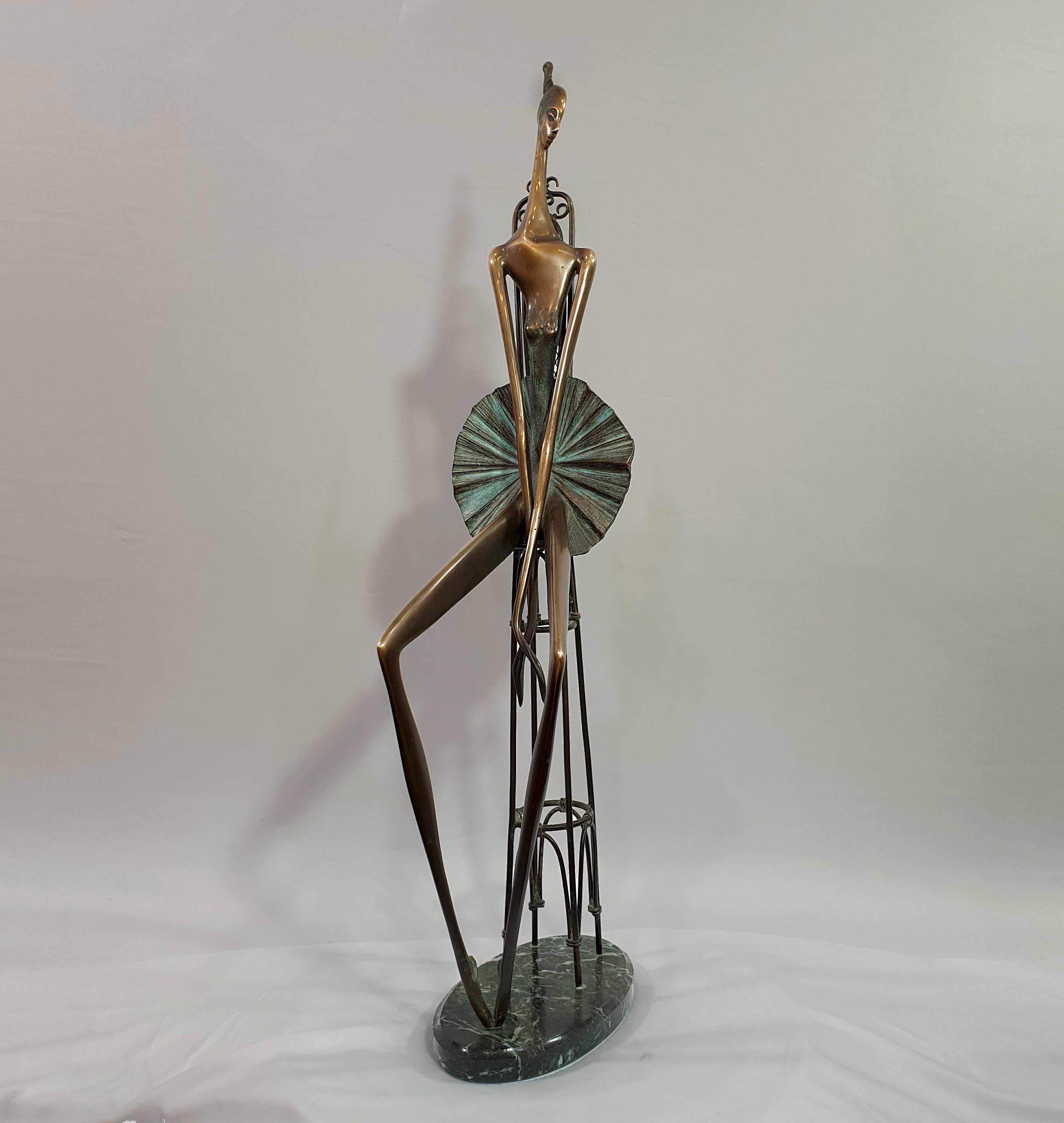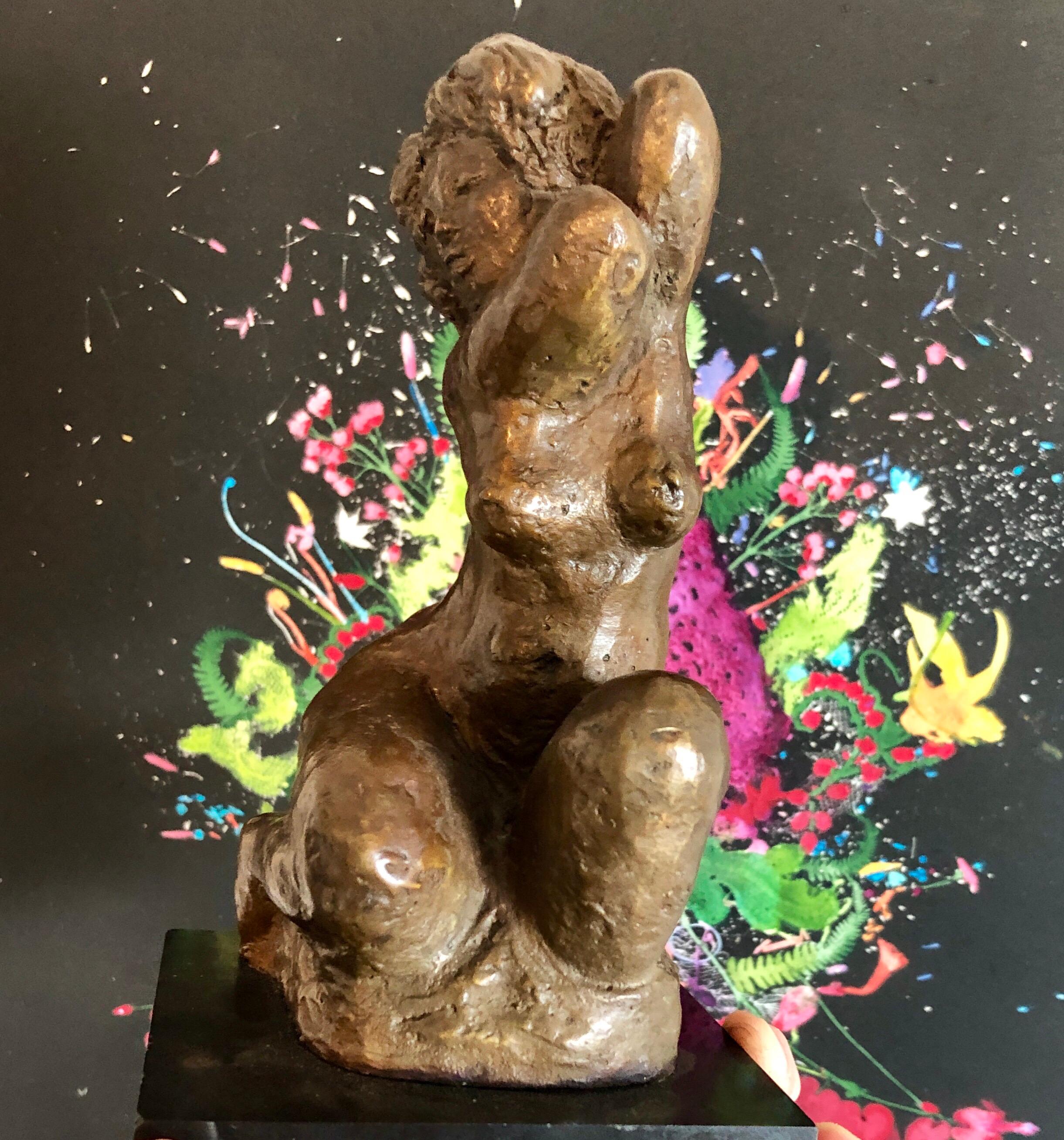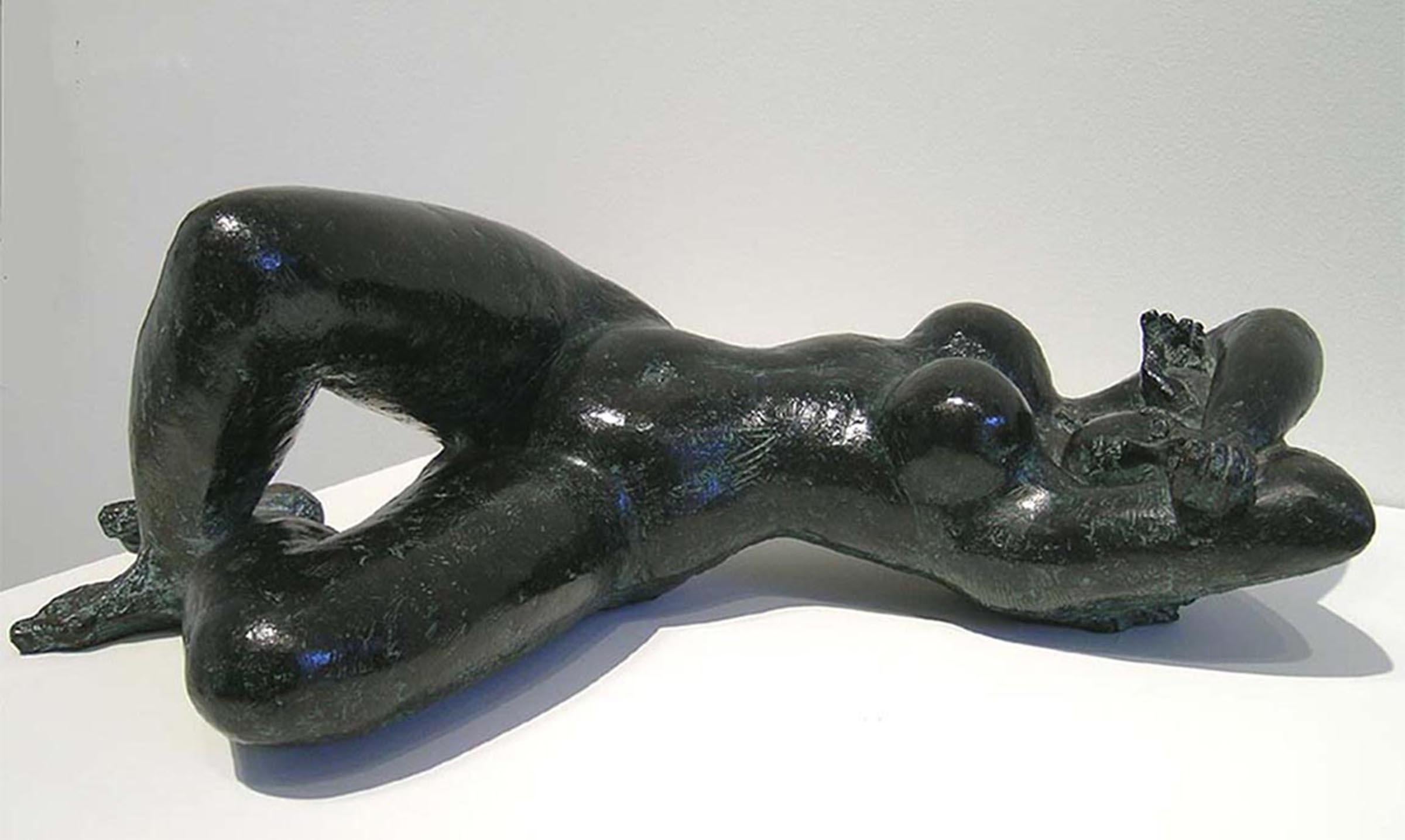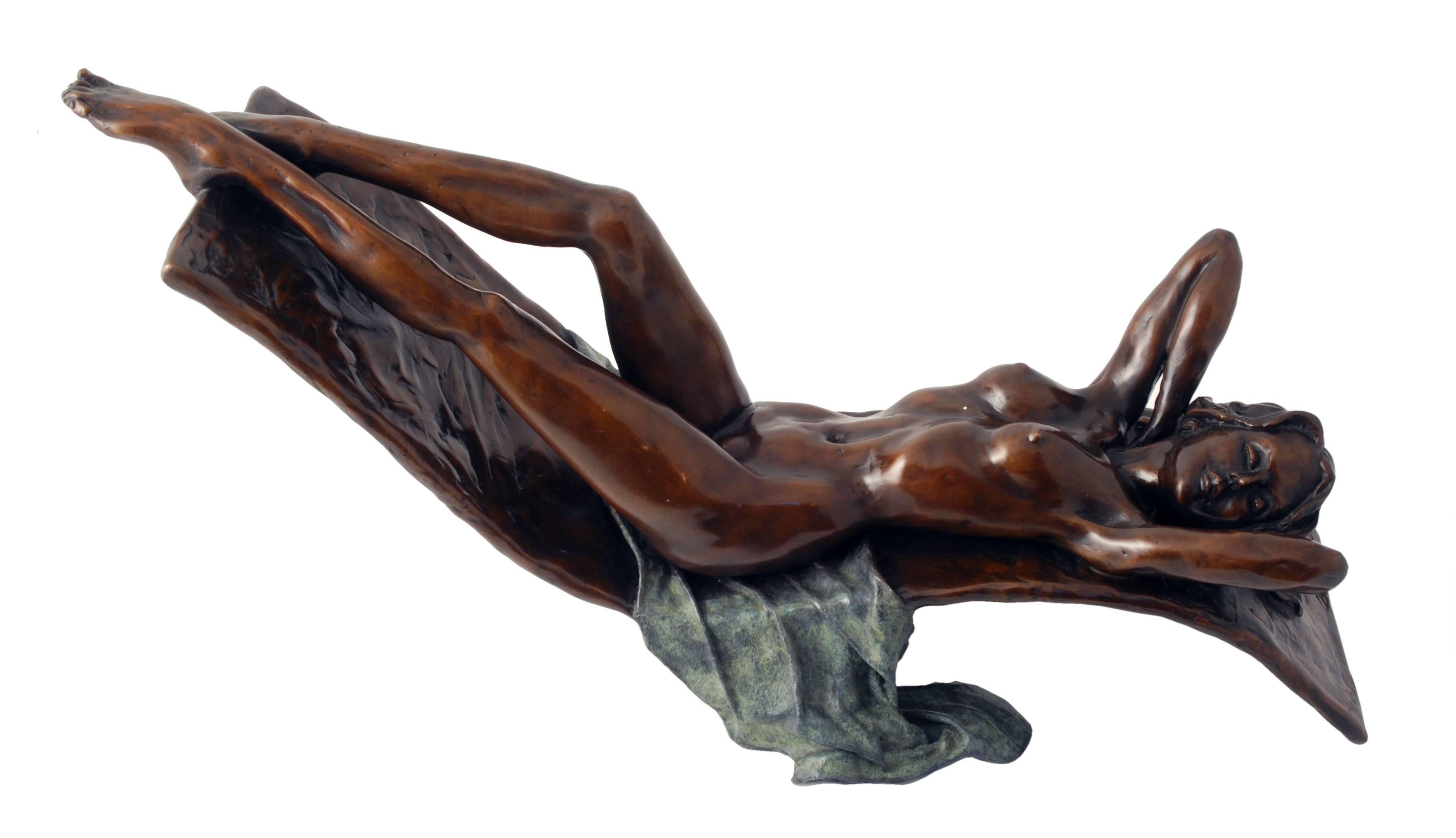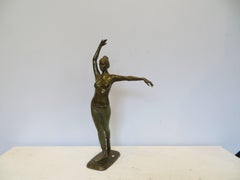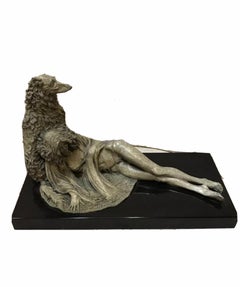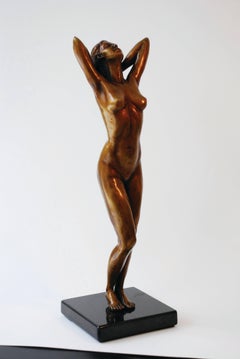Two Lovers, Couple Embracing
View Similar Items
Want more images or videos?
Request additional images or videos from the seller
1 of 7
Eli KarpelTwo Lovers, Couple EmbracingCirca 1980
Circa 1980
About the Item
- Creator:Eli Karpel (1916 - 1998, American)
- Creation Year:Circa 1980
- Dimensions:Height: 7.5 in (19.05 cm)Width: 6.5 in (16.51 cm)Depth: 4 in (10.16 cm)
- Medium:
- Movement & Style:
- Period:
- Condition:
- Gallery Location:San Francisco, CA
- Reference Number:Seller: 111621stDibs: LU66632302963
About the Seller
5.0
Platinum Seller
These expertly vetted sellers are 1stDibs' most experienced sellers and are rated highest by our customers.
Established in 1999
1stDibs seller since 2017
682 sales on 1stDibs
Typical response time: 1 hour
More From This SellerView All
- All DirectionsBy Frank HyderLocated in San Francisco, CAThis artwork titled "All Directions" 1987 is a wood bas-relief by noted American artist Frank Hyder, born 1951. It is signed, dated and titled on the verso. The size of the bas-relief itself is 15 x 18 inches, the over all size is 23.5 x 26.5 inches. The frame has been created by the artist. It is in good condition, the frame has minor original defects as crafted by the artist. About the artist. Frank Hyder has participated in more than 150 group shows and has had over 80 solo exhibitions throughout North, South and Central America, including 10 individual exhibitions in New York City. He has been one of the few North Americans to have solo museum exhibitions in Venezuela at the Museo de Arte Contemporaneo de Caracas Sofia Imber (MACCSI), Museo Jacobo Borges, Museo de Arte Contemporaneo Zulia (MACZUL), Museo Universidad de Los Andes and Museo de Arte Contemporaneo de Coro. Other solo museum exhibitions include the Pennsylvania Academy of Fine Art’s Museum of American Art, the Carnegie Museum in California, the La Salle Museum of Art in Philadelphia, and the National Museum of Catholic Art and History in New York. His solo installation “New World”, which debuted at the National Museum of Catholic Art and History in East Harlem, NYC, traveled to the Degenstein Gallery at the Susquehanna University in Selinsgrove, PA, the Anita Shapolsky Foundation in Jim Thorpe...Category
Late 20th Century American Modern Nude Sculptures
MaterialsWood Panel
- Cheval Libre (Free Horse)By Pierre Jules MêneLocated in San Francisco, CAArtist: After Pierre Jules Mene (French, 1810-1879) Title: Cheval Libre (Free Horse) Year: 1868 Medium: Cast bronze sculpture with dark brown patina Edition: Unknown Size: Inclu...Category
Mid-19th Century Realist Figurative Sculptures
MaterialsBronze
- Arabesque, Ballet DancerLocated in San Francisco, CAThis sculpture titled "Arabesque (Ballet Dancer)" 2001 is a cast bronze sculpture with silver patina by noted contemporary American artist Rebecca Clark. Signature, date and numbering /500 are impressed in the bronze on the deck. The sculpture size without the marble base is 28.25 x 17.75 x 13 inches, with the marble base is 29.5 x 17.75 x 13 inches. It is in mint condition. About the artist: Rebecca A. Clark is a Fine Artist and Creative Director with over 20 years of professional experience working in the fine art field in New York City. Her masterful artworks are collected by prominent art collectors worldwide. Rebecca specializes in figurative bronze sculptures, oil paintings, drawings and monumental works of art that embody dynamic strength and classic iconic beauty. Her artworks range from sensuous figurative sculptures to magnificent heroic size monuments. Commissioned works include “Battling Stallions”, her 18 ft. tall monumental bronze sculpture at the luxury gated development “Le Chevalier” in Barrington Heights, West Linn, Oregon, as well as her elegant 9 ft. tall ballerina bronze sculpture titled “Arabesque” on public display at the Oregon Ballet Theatre. Exclusive custom created works of art portray diverse concepts and themes for private and corporate collectors. Signature series include: Heroic series (Honoring American military Heroes), Inspirational, Classic Nudes and Romantic among other series and sculpture projects in development. Rebecca was born an artist and has always had the desire to achieve excellence in all of her endeavors. From a very early age she was immersed in imaginative creative works such as building models of futuristic cities, paintings, sculptures and a multitude of drawings. In 1981, at the age of 17, Rebecca moved from Lake Oswego, Oregon to New York City to pursue a career in fine art and design at the Parsons School of Design. Shortly after she arrived, Rebecca began her professional artistic career assisting the renowned illustrator Antonio Lopez. At age 18, Rebecca was hired by the famed designer Halston, and began working directly with him as a fashion designer and illustrator. Subsequently, she was discovered by the Ford Models agency and traveled around the world as a top international fashion model. Rebecca worked with renowned fashion photographers such as Richard Avedon, Bruce Weber, Steven Meisel, Patrick Demarchelier and others. Rebecca is experienced in working with the major media, including international publications such as Vogue, Harpers Bazaar, Elle, The New York Times and Glamour, among others, as well as in television. She was featured in a national Diet Slice-Style television commercial that was shown during halftime at the 1987 Super Bowl. Rebecca also appeared in top fashion shows in New York City and Paris, France and in international advertising campaigns such as Revlon’s “The Most Unforgettable Women In The World” ads photographed by Richard Avedon. In 1991, Rebecca left a prestigious modeling career to return to her true creative passion. She began creating a series of beautiful and universally appealing fine bronze sculptures and many commissioned works. In 1998, she began oil painting and studied at the New York Academy of Art, while creating oil paintings depicting the classic nude, equine, inspirational themes and portrait commissions for select art collectors. In 2001, Rebecca developed several digital film projects through her studies in the Film Directors Program at New York University. From 2001 to the present, she continues to create bronze sculptures, drawings, and oil paintings for private art collectors. In 2011, Rebecca was officially endorsed and directed by the National Special Forces Association to create The National Special Forces Green Beret...Category
21st Century and Contemporary American Realist Figurative Sculptures
MaterialsBronze
- The Foundry WorkerLocated in San Francisco, CAThis sculpture "The Foundry Worker" c.1925 is a bronze sculpture by German artist Albert Caasmann, 1886-1968. The signature is impressed in the bronze. The subject size is 11.15 x 8.15 x 3.15 inches, including marble base, the size is 13.15 x 8.15 x 5 inches. It is in excellent condition. about the artist: Albert Caasmann (2 June 1886 – 23 March 1968) was a German sculptor and porcelain artist. Caasmann designed toy figures for the Berlin toy company Lineol and from 1919 to 1952 was the lead designer and production manager for the company. He designed figurines for the porcelain companies Rosenthal AG and Volkstedt. Caasmann's work for the company Rosenthal are exhibited in the Porzellanikon's Rosenthal Museum. Lineol toy figures modeled by Caasmann are in the Historical Toy Museum in Freinsheim and the Toy museum in Havelland. Albert Caasmann was born on 2 June 1886 in Berlin, Germany. From 1909 to 1919, he worked as a freelancer for the Berlin toy company Lineol, founded by Oskar Wiederholz in 1906. After service as a soldier in the First World War, he became the leading designer and production manager of Lineol from 1919 to 1952. He designed over 600 figures for Lineol, including soldiers, animals, Indians, knights, fairy figures, and railroad figures. His toy figures were widely used in the region by children. Lineol ceased operations in 1965, and in 1985 the company Lineol Duscha has the trademark rights to Lineol. Lineol Duscha reproduces Lineol figures modeled before 1945. Lineol toy figures modeled by Caasmann are in the Historical Toy Museum in Freinsheim and the Toy museum in Havelland. Caasmann spent time in the Berlin Zoo, where he modeled his animal models. He made a model for a porcelain cheetah...Category
Early 20th Century Realist Figurative Sculptures
MaterialsBronze
- VogelBy Paul Edouard DelabriereLocated in San Francisco, CAArtist: Paul Edouard Delabrierre (French, 1829-1912) Title: Vogel Year: Circa 1900 Medium: Cast bronze sculpture, with dark brown patina Edition: Unknown Size: 12.3 x 9 x 9.25 inches Signature: Signed on the deck Condition: Excellent About the artist: Paul-Édouard Delabrièrre (29 March 1829 – 1912) was a French animalier sculptor who worked in the mid-to-late 19th century and the early 20th century. He had 70 of his sculptures juried into the prestigious Salon art exhibition held annually in Paris. His monumental work called L'Equitation adorns the facade of the Louvre museum. Delabrièrre was an important member of the animalier school who exhibited at the Salon from 1848 through 1882. His first two exhibits were typical of the style of his work throughout his career. He submitted Greyhound Holding a Hare and Wounded Deer. Most of his oeuvre were comparatively small models, however his larger pieces often incorporated figures. His work varies in style and quality with some models directly influenced by Antoine-Louis Barye who was the father of the animalier school. Delabrièrre's more popular realist bronzes were of impeccable quality and place him in the top echelon of his school. The facade of the Louvre incorporates one of his largest groups, the monumental L 'Equitation, which depicts a horse and two putti, one of whom is aboard the horse. It was completed by Delabrièrre in 1857 and installed that same year. In the final two years of his exhibiting career Delabrièrre experimented with iron as a worthy material for the Salon, although that idea did not go over well with collectors who were accustomed to bronzes. The works that were done in cast iron were produced by the art foundry Durenne Val Osne under the direction of Pierre Louis Rouillard. A list of Delabrièrre's 70 works presented at the Salon can be found in the Dictionnaire des Sculpteurs by Stanislas Lami. Versatility was one of Delabrièrre's strengths. The range of animals he sculpted covers nearly every large mammal to be found in continental Europe. He also did a few lion and panther sculptures during his career, as well as some camel and bird pieces, but his favorite subjects seemed to be dogs and big cats. He exhibited his Javanese panther in plaster at the 1857 Salon as well as Tigre du Bengale at the 1865 Salon. His repertoire also included some pieces executed in the orientalist genre. Delabrièrre used both the sand casting method and the lost wax method to create his sculptures. As early as December 1869 his sculptures had begun to be imported to the United States by the Philadelphia jewelry...Category
Early 20th Century Academic Figurative Sculptures
MaterialsBronze
- Chevre Allongee (Reclining Goat)Located in San Francisco, CAThis artwork "Chevre Allongee (Reclining Goat)" c. 1860, is bronze sculpture after renown French artist Antoine Louis Barye, 1796-1875. Signature is impressed in the bronze. The subject size is 4.25 x 7 x 3.35 inches, including marble base is 5.25 x 4 x 7.75 inches. It is in excellent condition. About the artist: Antoine-Louis Barye lived his entire life in Paris and may never have left France. He was born in 1795 (a date revised in the 1990s from 1796 as a result of Martin Sonnabend's recalculation of the Revolutionary calendar). He is reported to have had minimal formal schooling even in reading, and to have acquired his extensive liberal-arts education on his own. His initial professional training was in metalwork: first with his father, a goldsmith from Lyons, then with a metal engraver in military equipment, and finally with Martin-Guillaume Biennais (active 1800-1832), then master goldsmith to Napoleon. After serving in the army from 1812 to 1814, Barye trained in the fine arts with sculptor François-Joseph Bosio (1768-1845) and painter Baron Gros (1771-1835). He then studied at the Ecole des Beaux-Arts from 1818 to 1823. His miniature medallion, Milo of Crotona Devoured by a Lion, won an honorable mention in metal engraving in 1819, but he failed to win the Prix de Rome. He worked as a craftsman for the goldsmith Jacques-Henri Fauconnier (1779-1839) from 1823 to 1831 and made his Salon debut in 1827 with a selection of busts. Barye made his critical and public mark as a sculptor four years later, in the Salon of 1831, with groups representing predatory violence in the wild. His first government commission came soon after, precisely for such a subject. The Minister of the Interior purchased Barye's monumental plaster Lion (since called Lion Crushing a Serpent), shown in 1833, and had it cast in bronze by Honoré Gonon and shown in 1836, before placing it in the public Tuileries Gardens (now Musée du Louvre, Paris). In 1834 Barye was chosen for a project that was never executed, the colossal eagle as the crowning element of the triumphal arch at the Etoile. Around 1836 the government commissioned him to execute the emblematic animal decoration on the July Column at the place de la Bastille, inaugurated in 1840. He produced a monumental effigy of Saint Clotilde for the Church of the Madeleine, Paris, in the early 1840s. In 1846 the government commissioned a pendant Seated Lion for the Tuileries Lion Crushing a Serpent (1847, bronze, Portal, Pavillon de Flore, Palais du Louvre, Paris). During these same years the royal family began buying and commissioning small-scale works from Barye for their private collections. Around 1834, the duc d'Orléans commissioned a highly publicized surtout de table representing hunts of different regions and historical periods, possibly one of several tabletop projects that he ordered from Barye. The duc's sister Marie d'Orléans allegedly commissioned a lost-wax bronze of Barye's Charles VI Surprised in the Forest of Le Mans (location unknown; later serial variants), a model first shown in the Salon of 1833; his brother, the duc de Montpensier, apparently commissioned a pair of figurative...Category
Mid-19th Century Realist Figurative Sculptures
MaterialsBronze
You May Also Like
- sabineBy Patrick BrunLocated in Pasadena, CAPatrick BRUN was born in Paris in 1941. After obtaining his Engineering degree, he began his professional life as a teacher in mathematics and physics. After this period, he started ...Category
21st Century and Contemporary Modern Figurative Sculptures
MaterialsBronze
$5,241 Sale Price20% Off - LADY AND SCOTTISH DOGLocated in Pasadena, CAMagnificent beautiful masterpiece bronze sculpture of lady with the Scottish Deer Hunter dog bronze comes with green patina; 1/10 So beautiful and a lot...Category
2010s American Modern Figurative Sculptures
MaterialsBronze
$5,200 Sale Price20% Off - SophieBy Shazia ImranLocated in Palm Beach, FLBronzeCategory
21st Century and Contemporary Modern Nude Sculptures
MaterialsBronze
$15,800 - Nude Walking, Early 20th Century Bronze Sculpture, Cleveland School ArtistBy Max KalishLocated in Beachwood, OHMax Kalish (American, 1891-1945) Nude Walking, 1930 Bronze Signed and dated on base 17 x 9 x 4 inches Born in Poland March 1, 1891, figurative sculptor Max Kalish came to the United...Category
1930s American Modern Figurative Sculptures
MaterialsBronze
- Large Chaim Gross Mid Century Mod Bronze Sculpture Circus Acrobats WPA ArtistBy Chaim GrossLocated in Surfside, FLChaim Gross (American, 1904-1991) Patinated cast bronze sculpture, Three Acrobats, signed mounted on black marble plinth 24.5"h x 14"w x 7"d (bronze alone) Chaim Gross (March 17, 1904 – May 5, 1991) was an American modernist sculptor and educator. Gross was born to a Jewish family in Austrian Galicia, in the village of Wolowa (now known as Mezhgorye, Ukraine), in the Carpathian Mountains. In 1911, his family moved to Kolomyia (which was annexed into the Ukrainian USSR in 1939 and became part of newly independent Ukraine in 1991). When World War I ended, Gross and brother Avrom-Leib went to Budapest to join their older siblings Sarah and Pinkas. Gross applied to and was accepted by the art academy in Budapest and studied under the painter Béla Uitz, though within a year a new regime under Miklos Horthy took over and attempted to expel all Jews and foreigners from the country. After being deported from Hungary, Gross began art studies at the Kunstgewerbeschule in Vienna, Austria shortly before immigrating to the United States in 1921. Gross's studies continued in the United States at the Beaux-Arts Institute of Design, where he studied with Elie Nadelman and others, and at the Art Students League of New York, with Robert Laurent. He also attended the Educational Alliance Art School, studying under Abbo Ostrowsky, at the same time as Moses Soyer and Peter Blume. In 1926 Gross began teaching at The Educational Alliance, and continued teaching there for the next 50 years. Louise Nevelson was among his students at the Alliance (in 1934), during the time she was transitioning from painting to sculpture. In the late 1920s and early 1930s he exhibited at the Salons of America exhibitions at the Anderson Galleries and, beginning in 1928, at the Whitney Studio Club. In 1929, Gross experimented with printmaking, and created an important group of 15 linocuts and lithographs of landscapes, New York City streets and parks, women in interiors, the circus, and vaudeville. The entire suite is now in the collection of the Philadelphia Museum of Art. Gross returned to the medium of printmaking in the 1960s, and produced approximately 200 works in the medium over the next two decades. For more than sixty years Chaim Gross's art has expressed optimistic, affirming themes, Judaica, balancing acrobats, cyclists, trapeze artists and mothers and children convey joyfulness, modernism, exuberance, love, and intimacy. This aspect of his work remained consistent with his Jewish Hasidic heritage, which teaches that only in his childlike happiness is man nearest to God. In March 1932 Gross had his first solo exhibition at Gallery 144 in New York City. For a short time they represented Gross, as well as his friends Milton Avery, Moses Soyer, Ahron Ben-Shmuel and others. Gross was primarily a practitioner of the direct carving method, with the majority of his work being carved from wood. Other direct carvers in early 20th-century American art include William Zorach, Jose de Creeft, and Robert Laurent. Works by Chaim Gross can be found in major museums and private collections throughout the United States, with substantial holdings (27 sculptures) at the Hirshhorn Museum and Sculpture Garden. A key work from this era, now at the Smithsonian American Art Museum, is the 1932 birds-eye maple Acrobatic Performers, which is also only one and one quarter inch thick. In 1933 Gross joined the government's PWAP (Public Works of Art Project), which transitioned into the WPA (Works Progress Administration), which Gross worked for later in the 1930s. Under these programs Gross taught and demonstrated art, made sculptures that were placed in schools and public colleges, made work for Federal buildings including the Federal Trade Commission Building, and for the France Overseas and Finnish Buildings at the 1939 New York World's Fair. Gross was also recognized during these years with a silver medal at the Exposition universelle de 1937 in Paris, and in 1942, with a purchase prize at the Metropolitan Museum of Art's "Artists for Victory" exhibition for his wood sculpture of famed circus performer Lillian Leitzel. In 1949 Gross sketched Chaim Weizmann, President of Israel, at several functions in New York City where Weizmann was speaking, Gross completed the bust in bronze later that year. Gross returned to Israel for three months in 1951 (the second of many trips there in the postwar years) to paint a series of 40 watercolors of life in various cities. This series was exhibited at the Jewish Museum (Manhattan) in 1953. In the 1950s Gross began to make more bronze sculptures alongside his wood and stone pieces, and in 1957 and 1959 he traveled to Rome to work with famed bronze foundries including the Nicci foundry. At the end of the decade Gross was working primarily in bronze which allowed him to create open forms, large-scale works and of course, multiple casts. Gross's large-scale bronze The Family, donated to New York City in 1991 in honor of Mayor Ed Koch, and installed at the Bleecker Street Park at 11th street, is now a fixture of Greenwich Village. In 1959, a survey of Gross's sculpture in wood, stone, and bronze was featured in the exhibit Four American Expressionists curated by Lloyd Goodrich at the Whitney Museum of American Art, with work by Abraham Rattner, Doris Caesar, and Karl Knaths. In 1976, a selection from Gross's important collection of historic African sculpture, formed since the late 1930s, was exhibited at the Worcester Art Museum in the show The Sculptor's Eye: The African Art Collection of Mr. and Mrs. Chaim Gross. Gross was elected into the National Academy of Design as an Associate member, and became a full Academician in 1981. In 1984, he was inducted into the American Academy of Arts and Letters, with Jacob Lawrence and Lukas Foss. In the fall of 1991, Allen Ginsberg gave an important tribute to Gross at the American Academy of Arts and Letters, which is published in their Proceedings. In 1994, Forum Gallery, which now represents the Chaim Gross estate, held a memorial exhibition featuring a sixty-year survey of Gross's work. Gross was a professor of printmaking and sculpture at both the Educational Alliance and the New School for Social Research in New York City, as well as at the Brooklyn Museum Art School, the MoMA art school, the Art Student's League and the New Art School (which Gross ran briefly with Alexander Dobkin...Category
Mid-20th Century American Modern Figurative Sculptures
MaterialsMarble, Bronze
- Ballerina on a baroque chairLocated in Sempach, LUSculpture from the Ballet series. The series is dedicated to classical ballet and includes over 30 sculptures. This sculpture depicts a dancer tying p...Category
Early 2000s Modern Figurative Sculptures
MaterialsMetal, Bronze

